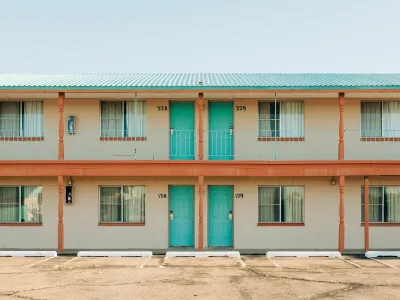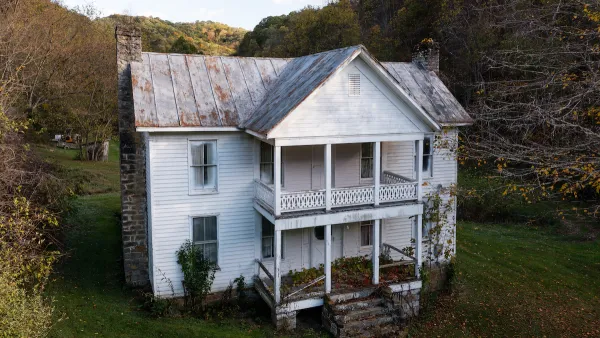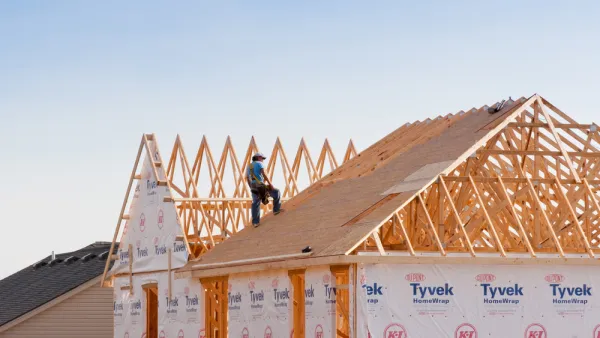Many guests at Motels4Now are on their second or third stays—but staff say that's doesn't equal failure, and the numbers bear that out.

Afternoons at Motels4Now are rarely boring.
In the parking lot outside a former Knights Inn in South Bend, Indiana, a young woman and an older man are engaged in a bitter argument. At times, the back-and-forth calms, only to loudly reconvene in one of the rooms or behind the building. The young woman, Clara (residents’ real names won’t be used here), issues a series of colorful, detailed threats and defies anyone to stop her from carrying them out. “I heard the cops are coming!” she yells. “Where are they? I ain’t afraid!”
Soon after, a city police officer does drive up, but by then Clara has left. The police officer pulls away, ignoring a young man riding his bicycle in tiny circles in the middle of the parking lot and a woman who emerges from one of the rooms every few minutes to levy rapid-fire accusations to no one in particular. A heavily bearded man takes it all in from his spot in a stained beige recliner next to thedumpster, drinking from a 25-ounce can of Hurricane High Gravity malt liquor, a small pile of empties at his feet.
Another man hurriedly walking across the parking lot is greeted by Motels4Now director Sheila McCarthy, who welcomes him back after a short jail stint for violating his probation as a sex offender. McCarthy returns to the staff office, two motel rooms with the separating wall knocked out. A diagram on the wall notes the risk levels of injecting drugs into different areas of the body. Desperation can trump discretion, though: one of the residents was recently treated for a large injection-created abscess in her neck.
Motels4Now is a low-barrier shelter, meaning that residents do not have to demonstrate sobriety or medication compliance to be able to stay. The staff estimates that nearly all of the 115 residents are dealing with at least one severe mental illness, often including addiction. About 80 percent have lived on the streets for a year or more, and few are able to consistently keep any employment besides occasional one-off jobs. More than half of the current residents are on their second stay here, usually because they have been asked to leave during previous stays, usually after repeated unauthorized visitors or conflicts with other residents.
The challenges are on high-volume display, but McCarthy points out some less obvious signs of success. A group of older men sit and talk in chairs they have set up on the narrow sidewalk in front of their rooms. Among them is Lawrence, who lived outdoors for 18 years before being invited to move to Motels4Now. There was an adjustment period—Lawrence at first did not want to spend the night indoors, and then he struggled to break his habit of hoarding food for weeks on end. But now he is settling in, regularly getting medical care for the first time in four decades, and enjoying the security of a locked door to protect him at night. “It is a myth that people prefer to be homeless if they have an alternative that allows them safety and respect,” McCarthy says.
Motel4Now’s most impressive success stories are no longer on site. A full three-quarters of former residents, 400 people in total, now live in stable long-term housing. Those who have not yet joined them are on the same path, McCarthy insists, even while dealing with profound challenges exacerbated by years on the streets. She points to the office wall opposite the safe injection poster where a print made by a local artist reads “Housing is Healing.” “You can see when our repeat guests come back, they are a little better each time,” McCarthy says. “It is visibly transformative for them to have a roof over their heads.”
McCarthy picks an unlikely example: Clara, the young woman who was just threatening a fellow resident. Overall, Clara’s stay was much more peaceful than her past times at Motels4Now, McCarthy says. Like all the others who have been asked to leave, Clara will be assured that she is automatically on the waiting list for a return stay, and she will be welcomed back when her name gets to the top of that list.
FULL STORY: FULL STORY

National Parks Layoffs Will Cause Communities to Lose Billions
Thousands of essential park workers were laid off this week, just before the busy spring break season.

Retro-silient?: America’s First “Eco-burb,” The Woodlands Turns 50
A master-planned community north of Houston offers lessons on green infrastructure and resilient design, but falls short of its founder’s lofty affordability and walkability goals.

Delivering for America Plan Will Downgrade Mail Service in at Least 49.5 Percent of Zip Codes
Republican and Democrat lawmakers criticize the plan for its disproportionate negative impact on rural communities.

Test News Post 1
This is a summary

Test News Headline 46
Test for the image on the front page.

Balancing Bombs and Butterflies: How the National Guard Protects a Rare Species
The National Guard at Fort Indiantown Gap uses GIS technology and land management strategies to balance military training with conservation efforts, ensuring the survival of the rare eastern regal fritillary butterfly.
Urban Design for Planners 1: Software Tools
This six-course series explores essential urban design concepts using open source software and equips planners with the tools they need to participate fully in the urban design process.
Planning for Universal Design
Learn the tools for implementing Universal Design in planning regulations.
EMC Planning Group, Inc.
Planetizen
Planetizen
Mpact (formerly Rail~Volution)
Great Falls Development Authority, Inc.
HUDs Office of Policy Development and Research
NYU Wagner Graduate School of Public Service





























